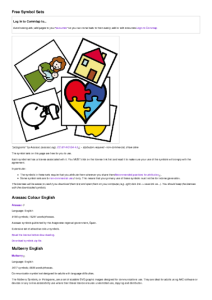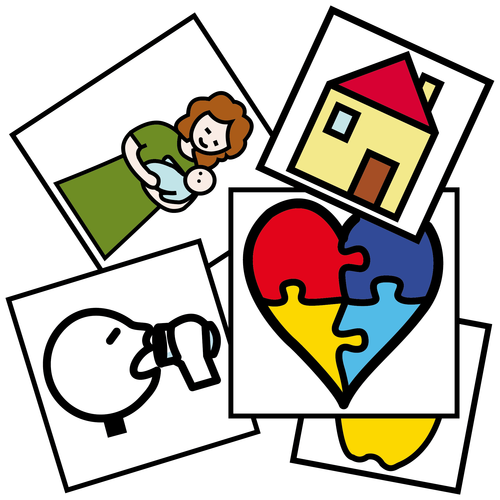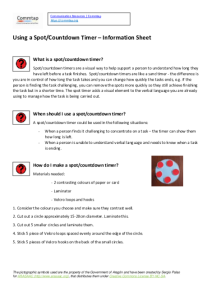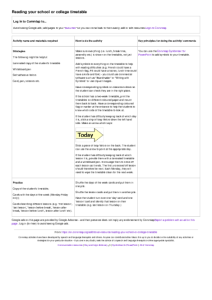Search
User login
Topic “Routines”
Information sheet - using a spot/countdown timer
Created 13 July 2021; updated 24 October 2021.
Reading your school or college timetable
Created 15 May 2012; updated 6 December 2024.
Reading your school or college timetable
| Activity name and materials required |
To order three daily events using pictures
| Activity/strategy name and materials required | How to do the activity | Key principles for doing the activity and comments |
|---|---|---|
| Picture sequences with first/next/last template This is a preparatory activity for working on sequencing daily events. See also the following (at www.commtap.org): Sequences three or more pictures; Sequences three pictures with first next last; Sequence pictures symbols words Materials required: Your own or commercially produced sequencing cards (e.g. Black Sheep press - see "general resources"), Colorcards - available from many educational suppliers) FIRST/LAST template which looks like this (leaving spaces to put the pictures): FIRST LAST FIRST/NEXT/LAST template, as follows (leave spaces for the pictures): FIRST NEXT LAST | 1. Use the first/last template to model the sequence of first and last. 2. Start with 2 picture sequences of a simple event e.g. 'rain falling' 'girl puts up umbrella'. 3. Talk about the pictures. Ask the child 'What is happening in the first picture?' Discuss the consequences of the first picture (getting wet) and what the girl does (puts up the umbrella) 4. Put the two pictures into the template: one in the FIRST column and the other in the LAST column. 5. Do this with a range of 2 sequence picture stories. 6. Turn the cards face down and take turns to turn them over and put them in the right part of the FIRST/LAST template. Can the child tell the story? 7. When the child is confident using the FIRST LAST template to order 2 picture sequences move onto using 3 picture sequences and use the FIRST/NEXT/LAST template. 8. Follow the procedure for working with 2 picture sequences. | Prepare materials in advance. Give a child time to familiarise him/herself with teaching materials and comment on them if needed before starting the learning activity. Give lots of praise. Correct mistakes gently! You can also look confused if the child tells the story in the wrong order. For children who are having difficulties grasping the connection between the picture sequence and an actual event, start with simple sequences you can actually act out - such as pouring a drink - and match a picture with each step of the sequence - e.g. (1) empty glass, full bottle, (2) pouring from bottle into the glass, (3) full glass, half empty bottle. |
| Photos of school life FIRST/NEXT/LAST template Photos of familiar aspects of school life (use a digital camera to take photos) | To help the child build links between the pictures and real events and their order, show them the pictures when the events are actually happening. |
Organise daily routine pictures on school and non school day
| Activity/strategy name and materials required | How to do the activity | Key principles for doing the activity and comments |
|---|---|---|
| Sequencing Strips Pictures of activities relevant to a school day e.g. break time, different lessons Pictures of activities relevant to a weekend day e.g. going to the park, going to the shops A strip of card with Velcro on it, long enough to fit the whole sequence on it / timeline | 1. Start with just one set of pictures; the school day ones will have the least variation and so should be easier. 2. Go over what the pictures are first. 3. Have the child put them in the right order on the strip to fit their own day. 4. Discuss any variation in routines, and use sequencing language such as 'before, after, first, then, next'. Refer to time for well known points, e.g. start of school, lunch time, home time. Emphasise concepts of 'morning, afternoon, evening, night'. 5. Introduce pictures of activities at home and put in order for a weekend or holiday day. When the children are confident with this, you could give them all the pictures and have them sort them out. | If sequencing a whole day is too hard, either reduce the number of cards or reduce the task to just the morning or just the afternoon. You could also put some of the key markers on the strip, e.g. start school, lunch, go home. When the children are confident with the activity, discuss which things they do both on a school day and a non-school day. See also: "order three daily events using pictures" on www.commtap.org |
| Design an ideal day Pens / pencils Paper Glue Scissors | You may need to model this activity by talking about your ideal day. | |
| Commercially available activities Black Sheep Worksheets: There are several relevant packs, including 'times of the day' and 'days'. |
Support Commtap to keep it online
Thank you for visiting Commtap.
Please read this message as it is extremely important.
- Visitor donations mean we can continue to host over 1,000 free activities to support speech, language, and communication development.
- Visitor donations mean we can continue to provide free resources to address a wide range of communication needs, including limited speech or language, interaction challenges, and needs associated with conditions such as developmental language disorder, autism, and cerebral palsy.
- Visitor donations mean we can continue to provide resources to support the work of speech and language therapists, teachers, teaching assistants, parents, and carers.
- Visitor donations mean we can continue to provide the free key word sign dictionary (bks.org.uk) which has over 2,000 Makaton and Signalong signs.
We know that not everyone is able to afford to pay to access these resources, however, if you can, please make a donation to keep the site going.
Thank you
Google ads on this page are provided by Google Adsense - and their presence does not imply any endorsement by Commtap. Report a problem with an ad on this page. Log in (for free) to avoid seeing Google ads.




